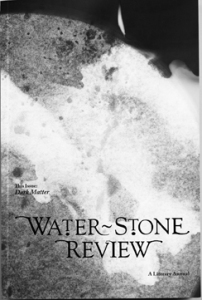Magazine Review: Water~Stone Review Volume 15: Dark Matter edited by Mary François Rockcastle
This literary journal is published by Hamline University in Minnesota. The title comes from another name of the Philosopher’s Stone, the transformative agent which turned base metals into gold, in the search for true immortality, as literature turns ordinary words into art. This issue’s theme is “dark matter” the unknown encountered and given a name by humans in an attempt to categorize it.
This issue is heavy on the poetry, unfortunately, most of it is modern poetry which (as I have mentioned before) I do not have the tools to fully appreciate–I can’t even tell good modern poetry from bad. I did like Ruth Stone’s “Train Ride” which at least has a rhyme scheme and comprehensible imagery. Also of note is “Song for the Generations: December 26, 1862” by Gwen Westerman. It’s about the mass hanging of Native Americans in Minnesota as a result of a rebellion, and uses a particular line structure to reflect this event. (For more on this subject, see my review of The Thirty-Ninth Man by Dale Swanson.) It’s also the poem in this issue that caused the most dissension in the editorial office, as different families learned different stories of the event.
One of the two book reviews covers three books of modern poetry–because of my previously-mentioned problem, it read like gibberish to me. There’s also an interview with poet Ralph Angel, and that was mildly interesting.
The fiction and “creative non-fiction” sections are very similar, being mostly melancholy stories about relationships with parents or loved ones that stop rather than have endings. Of the fiction, the most striking was “Missions, 1969” by Anastasia Faunce. A little girl is used as a servant at her mother’s moon-themed party, and learns yet another lesson about the casual cruelty of adults.
From the non-fiction section, the two most interesting pieces are “Elegy for the Old NIght Sky and Other Bodies” by Katie Hae Leo, about childlessness, being an adoptee, and dark matter; and “Dust to Dust” by Amy Roper, about the author’s job cleaning fossils for a museum.
There are also visual arts, a section of photographs titled “Open. Shut. Open.” It’s pretty random-feeling, some are in color, a few are interesting. Lawrence Sutin contributes two “erasure pieces” in which he has taken old books and erased most of the words to create “found” poetry. It seems like a mutilation of perfectly good books to me.
The concluding piece is another book review, three books that reflect the reviewer’s hobby of collecting other people’s home movies.
Due to my dislike of modern poetry and the generally depressing nature of most of the prose pieces, I did not get much out of this magazine, despite the above-average quality of writing. If modern poetry is your bag, I think you’ll appreciate this much more than I did.


I always appreciate your reviews, and given that I like modern poetry and dark edges, this may well be an issue I want to pick up. Hope your next reading choice is one more is to your liking.
It’s a Halloween flavored book, so far so good.
Scott, I appreciate your frankness. I was not aware of this magazine, but I have read a memoir by Lawrence Suton. It was structured around memories triggered by his collection of antique postcards, an interesting process.
That does sound like an interesting way to structure a memoir. It helps, I think if you have lots of interesting memories and can tell them well.
A fair and balanced review, skjam. 😀 I am not a lover of poetry that rhymes so this might be one for me. Thanks!
Best of ;luck. I know there are a lot of good poets that need wider exposure.
I used to read literary magazines years ago. Then I succumbed to the modern cozy mystery, and there was no going back. But lately I have hungered for those old journals. Your review is very timely for me.
It’s interesting that you mention that some stories simply stop, rather than having endings. Just this week, I’ve realized that that’s true in many of my own stories, which is one of the reasons they haven’t seen light of day. Closure is a true art, in life as well as literature. It’s something I’m learning right now.
For a tongue-in-cheek take on the art of reading poetry, you might click through to this humor column. Of course, it in itself may be gibberish, too. 😉
http://therumpus.net/2013/06/funny-women-102-how-to-read-a-poem/
A story that simply stops rather than having an ending is its own art form–I’ve seen ones that do it very well, but they are rare. Thanks for the essay link!
Scott, glad to hear about your job. It’s a start, hang in there:)
Thanks!